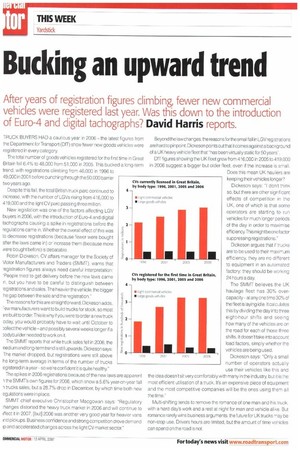Bucking an upward trend
Page 22

If you've noticed an error in this article please click here to report it so we can fix it.
After years of registration figures climbing, fewer new commercial vehicles were registered last year. Was this down to the introduction of Euro-4 and digital tachographs? David Harris reports.
TRUCK BUYERS HAD a cautious year in 2006 -the latest figures from the Department for Transport (DfT) show fewer new goods vehicles were registered in every category.
The total number of goods vehicles registered for the first time in Great Britain fell 6.4% to 48,000 from 51,000 in 2005. This bucked a long-term trend, with registrations climbing from 46,000 in 1996 to 49,000 in 2001 before punching through the 50,000 barrier two years ago.
Despite this fall, the total British truck parc continued to increase, with the number of LGVs rising from 416,000 to 419,000 and the light CV parc passing three million.
New legislation was one of the factors affecting LGV buyers in 2006, with the introduction of Euro-4 and digital tachographs causing a spike in registrations before the regulations came in. Whether the overall effect of this was to decrease registrations (because fewer were bought after the laws came in) or increase them (because more Nere bought before) is debatable,
Robin Dickeson, CV affairs manager for the Society of Motor Manufacturers and Traders (SMMT), warns that 'egistration figures always need careful interpretation 'People tried to get delivery before the new laws came n, but you have to be careful to distinguish between -egistrations and sales. The heavier the vehicle, the bigger he gap between the sale and the registration," The reasons for this are straightforward, Dickeson adds. =ew manufacturers want to build trucks for stock, so most 3re built to order. This is why if you were to order a new truck oday, you would probably have to wait until October to :ollect the vehicle-and possibly several weeks longer if a Dadybuilder needed to work on it.
The SMMT reports that while truck sales fell in 2006, the nedium and long-term trend is still upwards. Dickeson says: The market dropped, but registrations were still above he long-term average in terms of the number of trucks egistered in a yearso we're confident it is quite healthy."
The spikes in 2006 registrations because of the new laws are apparent -I the SMMT's own figures for 2006, which show a 5.6% year-on-year fall -1 trucks sales, but a 28.7% drop in December, by which time both new egulations were in place.
SMMT chief executive Christopher Macgowan says: "Regulatory :hanges distorted the heavy truck market in 2006 and will continue to iffect it in 2007, [but] 2006 was another very good year for heavier vans Ind pickups. Business confidence and strong competition drove demand ip and accelerated changes across the light CV market sector."
4 — 3 — 2 —
4 —
Beyond the law changes, the reasons forthe small fall in LGV registrations are hard to pinpoint. Dickeson points out that it comes against a background of a UK heavy vehicle fleet that "has been virtually static for 50 years'.
DfT figures showing the UK fleet grew from 416,000 in 2005 to 419,000 in 2006 suggest a bigger but older fleet, even if the increase is small. Does this mean UK hauliers are keeping their vehicles longer?
Dickeson says: "I don't think so, but there are other significant effects of competition in the UK, one of which is that some operators are starting to run vehicles for much longer periods of the day in order to maximise efficiency. This might beonefactor suppressing registrations."
Dickeson argues that if trucks are to be used to their maximum efficiency, they are no different to equipment in an automated factory: they should be working 24 hours a day.
The SMMT believes the UK haulage fleet has 30% overcapacity-at anyone time 30% of the fleet is laying idle. It calculates this by dividing the day into three eight-hour shifts and seeing how many of the vehicles are on the road for each of those three shifts. It doesn't take into account load factors, simply whether the vehicles are being used.
Dickeson says: "Only a small number of operators actually use their vehicles like this and the idea doesn't sit very comfortably with many in the industry, but it is the most efficient utilisation of a truck. It's an expensive piece of equipment and the most competitive companies will be the ones using them all the time."
loot 200! 2005 2006
Multi-shifting tends to remove the romance of one man and his truck, with a hard day's work and a rest at night for man and vehicle alike. But romance rarely wins business arguments: the future for UK trucks may be non-stop use. Drivers hours are limited, but the amount of time vehicles can spend on the road is not.


















































































































































































